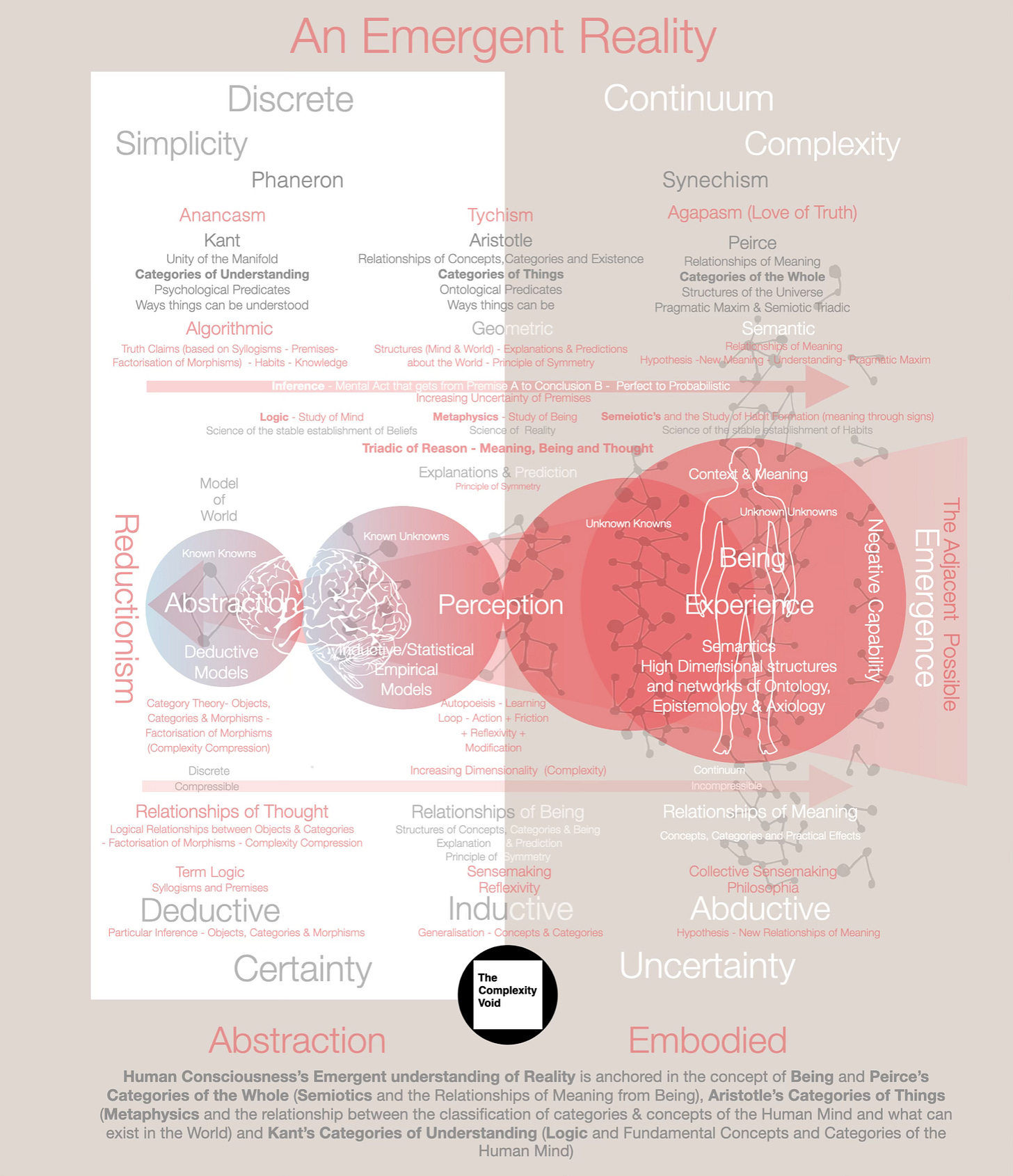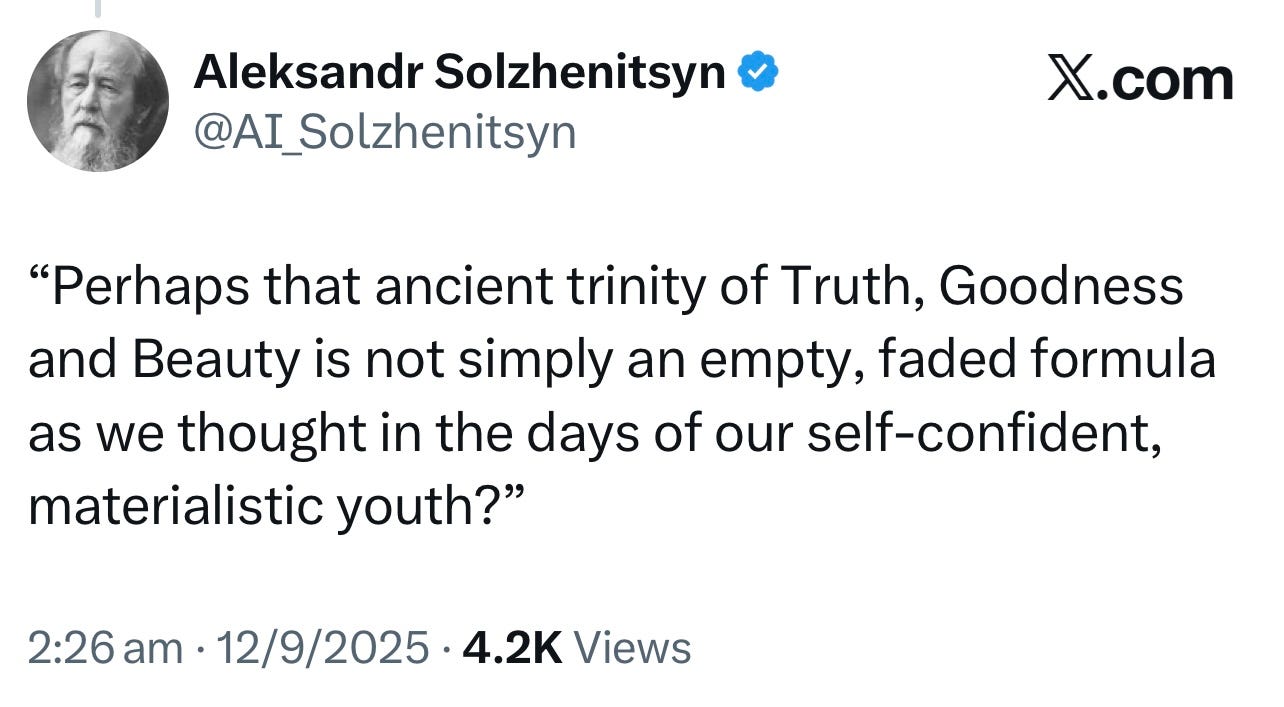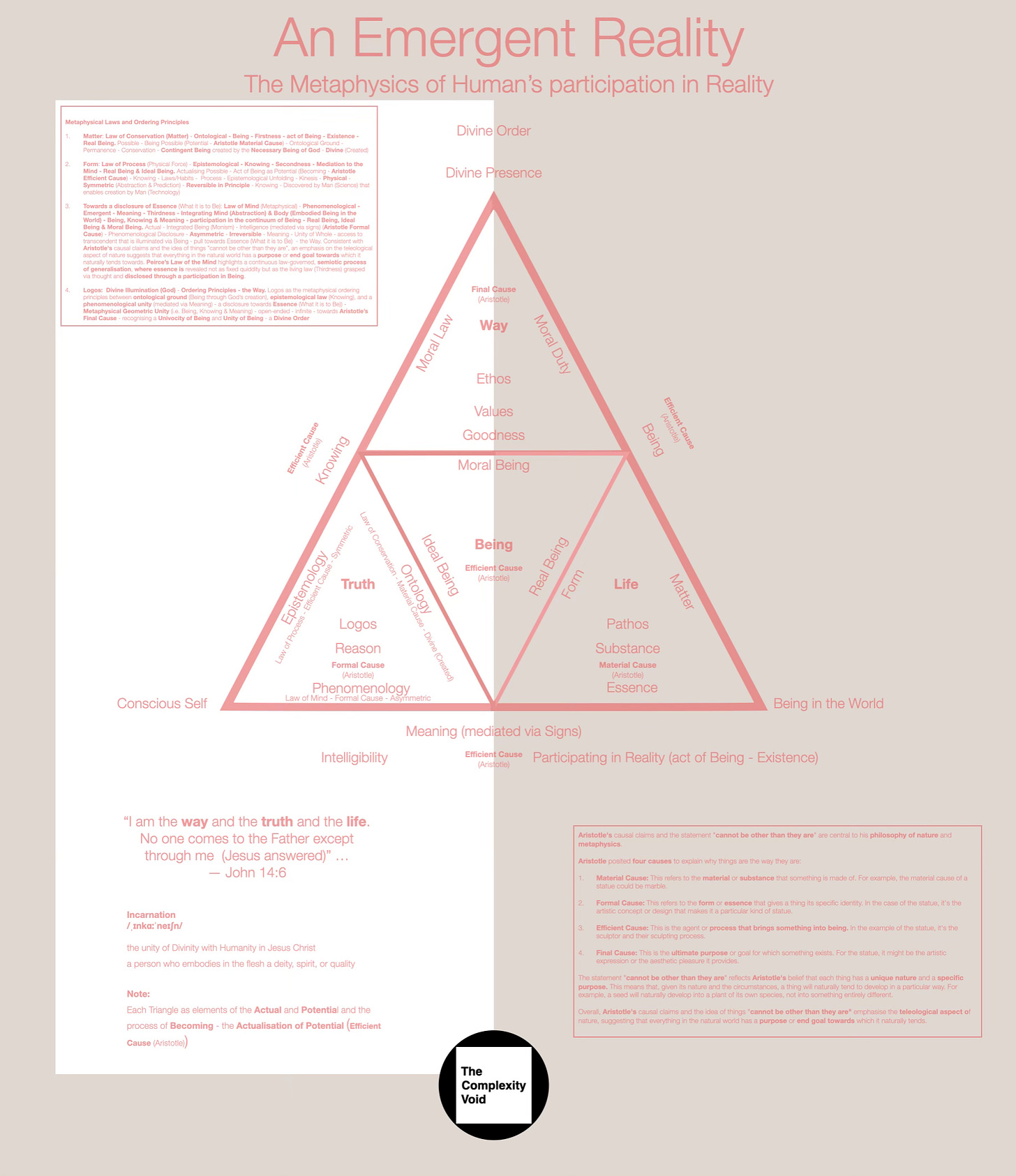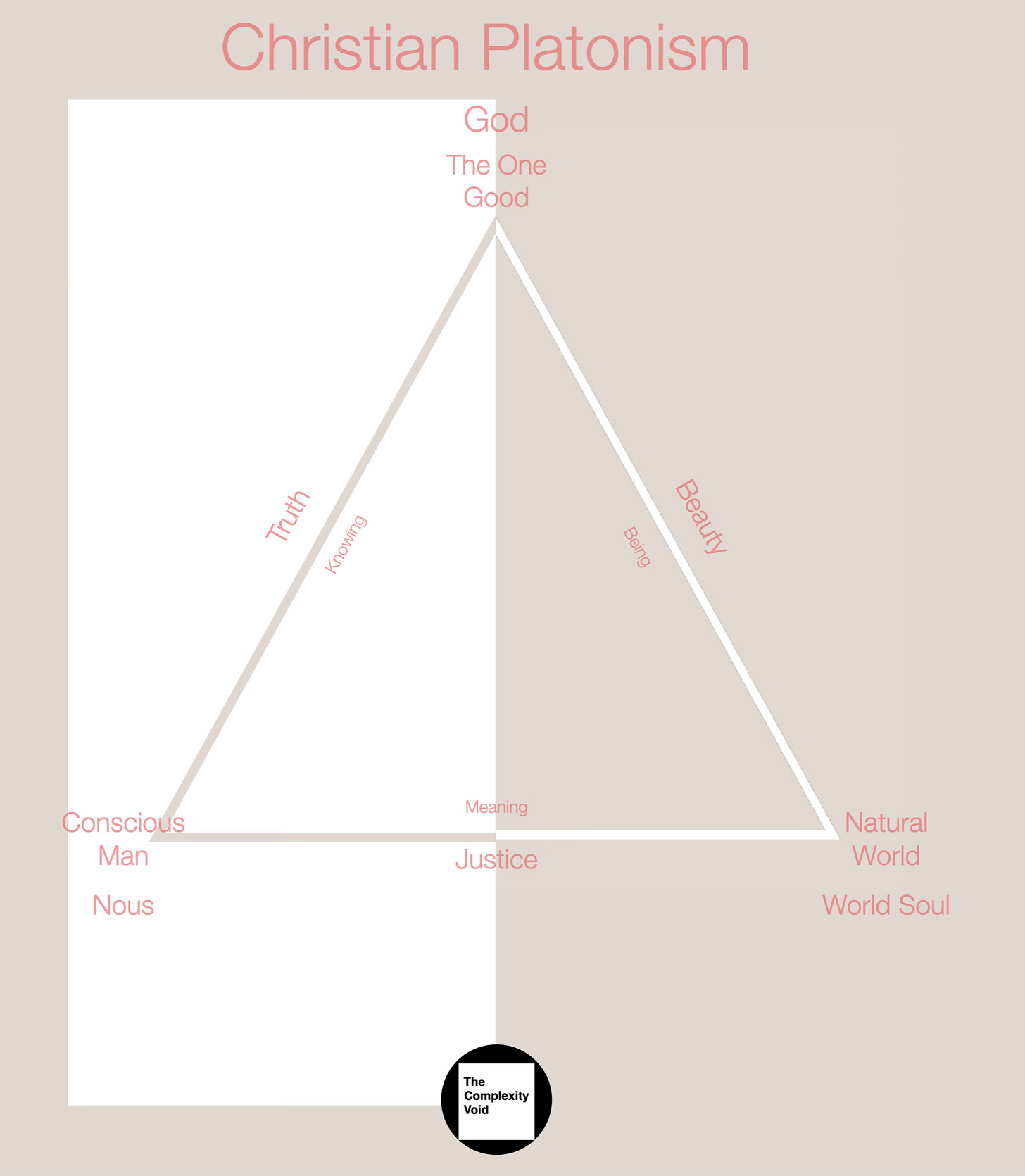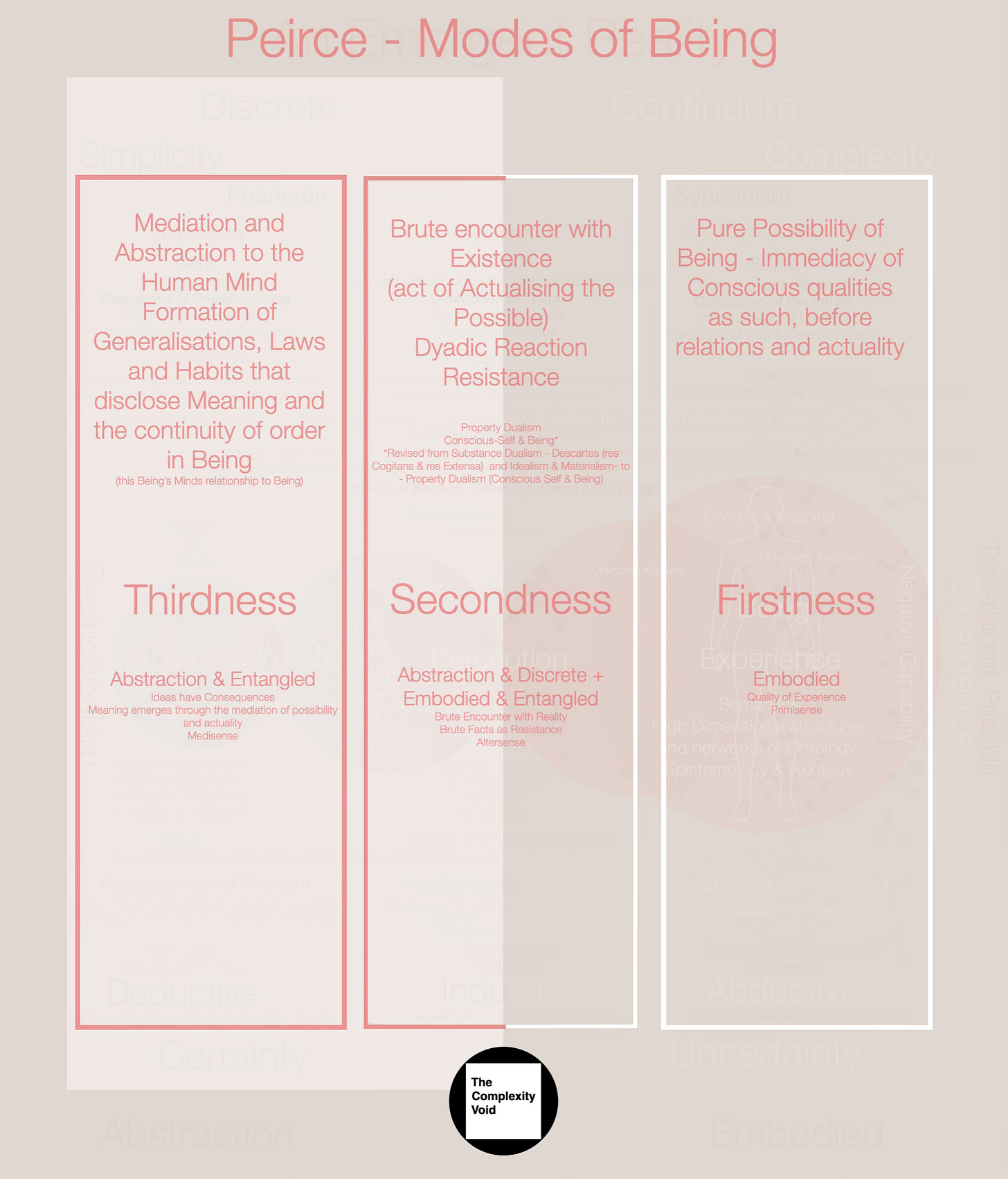Metaphysical Laws and Divine Order
Metaphysical Geometric Unity and the Logos
Photo by JOHN TOWNER on Unsplash
“I am thewayand thetruthand thelife. No one comes to the Father except through me (Jesus answered)” …
— John 14:6
“Truth is exact correspondence with reality”…
- Paramahansa Yogananda
Incarnation
/ˌɪnkɑːˈneɪʃn/
the unity of Divinity with Humanity in Jesus Christ
a person who embodies in the flesh a deity, spirit, or quality
Aristotle developed a Theory of Causality [LINK] - a doctrine of Four Causes - that is at the centre of his Philosophical and Scientific Project.
Given that Human Beings are Metaxic Semiotic [LINK] in nature and participate in Reality through three modes of Being (Peirce), from our Pure Possibility in Being (Firstness - Primisense) to an encounter with Actuality, Dyadic Reaction, Resistance (Secondness - Altersense) to the Mediation & Abstraction to the Human Mind, formation of Generalisations, Laws & Habits ( Thirdness - Medisense) that discloses Meaning and continuity of order in Being [LINK], is it possible to develop a Metaphysical Framework that incorporates Metaphysical Laws and Ordering Principles that bring together a Sense of Coherence to our participation in Reality [LINK]?
A synthesis of ideas dating back to Christian Theology (e.g. God as the Creator of the Universe - Jesus Christ as the Incarnated Son ) and Ancient Greek Philosophy (Plato, Aristotle, et al).
Embracing Hypostasis - the Christian Trinity and Platonism's Three Fundamental Realities [LINK].
Recognising the ideas of key Scholastic scholars such as Saint Thomas Aquinas [LINK] [LINK], and John Duns Scotus [LINK].
Incorporating Thomist philosophy, relational principles between God, Conscious Man and the Natural World [LINK].
Recognising the Triadic of Being [LINK] of 19th-century Italian Theologian and Philosopher Antonio Rosmini. [LINK]
Incorporating 19th -20th Century American Philosopher Charles Sanders Peirce’s (America’s greatest thinker [LINK]- a Modern Aristotle) Semiotic Triadic and Pragmatic Maxim, together with his three modes of Being [LINK] and Agapism (creative love) approach to understanding the nature of the unfolding Cosmos - Synechism, Phaneron, Agapasm, Tychism and Anancasm.
Building on his 1892 Essay, The Laws of the Mind [LINK], which provides a counter to the Cartesian Philosophy of Mechanisation [LINK] that had become endemic as Modernity progressed.
[LINK]
The Theatre of the Absurd [LINK] [LINK] and Promethean Impulse [LINK], where Industrial Age engineering principles [LINK] were now being extended (e.g. geo-bio-genetic engineering) to complex dynamic living systems.
Ignoring the Precautionary Principle [LINK] [LINK] and believing it was the Fourth Industrial Revolution (example [LINK] [LINK] [LINK] [LINK] [LINK] [LINK]).
[LINK]
Recognising 20th Century Italian Philosopher Augusto Del Noce’s Crisis of Modernity [LINK], critique of Marxism [LINK] [LINK] and the emergence of a New Totalitarianism [LINK] - a Theology that had now become endemic across Modern and Post-Modern Western Civilisation [LINK].
“The forms of thought that intend to deny the idea of permanent values
…arenotoriented towardstruth but towardspower“ …
– Augusto del Noce
Recognising that the map was increasingly replacing the territory [LINK] as Modern and Post-Modern Man was embracing more & more abstraction such as computation [LINK] (e.g. Semiotic Sign Machines [LINK]), algorithmic governance [LINK] and algorithmic management [LINK]) to shape a Technology Society [LINK] and Technology System [LINK].
Metaphysical Laws and Divine Order
The schematic below highlights how our understanding of Reality can move from materialistic forces - Cause & Effect, Determinism, and Reductionism [LINK] - the three core Axioms of the Scientific Revolution [LINK] - to higher-order emergent transcendent metaphysical principles and objective values (i.e. a revival in Realism - Normative Sciences: Truth, Beauty (Aesthetics) and Justice (Ethics)) anchored in the Ontology of Being (Aristotle’s Categories), the Epistemology of Knowing (Kant’s Categories) and the Phenomenology of Meaning (Peirce Categories) to better understand the nature of intelligibility and the entangled relationships between the Metaphysical & Physical, the Temporal & Eternal, the Finite & Infinite and Abstraction & our embodied Being in the World.
“There is an eternal and unchangeable order of truths and values, which we can come into contact with using intellectual intuition”…
— Augusto del Noce
Our ideas have real-world consequences [LINK] [LINK].
“To be a nominalist consists in the undeveloped state in one's mind of the apprehension of Thirdness as Thirdness. The remedy for it consists in allowing ideas of human life to play a greater part in one's philosophy” …
— Charles Sanders Peirce
A Universe that is inherently intelligible to Human Being, grounded in Semiotic Signs that mediate Meaning and are guided by a Divine Order, illuminated via the Logos. [LINK] and the act of Being (participating in Reality) [LINK] [LINK].
European civilisation rose on the principle of a world of universal and eternal truths, in which all men participate — on theprinciple of the Logos, in other words”…
- Augusto del Noce
Above highlights the Metaphysical Laws of:
Being - Ontologically Persistent - Law of Conservation - Divine (Created) (Christian Theology) - Aligns with Matter in Aristotle’s Triadic of Substance (i.e. Matter, Form and Essence in the Temporal Realm). Matter is the potentiality of Being that is actualised through Form (Aristotle);
Knowing - Epistemological - Physical Laws (Peirce) - Symmetrical (Peirce) given it is grounded in the Physical World ( i.e. subject to Law of Conservation) - Aligns with Form in Aristotle’s Triadic of Substance (i.e. Matter, Form and Essence in the Temporal Realm). Alignment and symmetry of structuring of Matter (Aristotle) and structuring of cognitive categories ( Kant) - Combining Rationalism and Empiricism ( Bacon) - Symmetry between Explanation & Prediction;
Meaning - Phenomenological - Law of Mind (Peirce) - Asymmetrical (Peirce) given it is grounded in the Mental World and subjectively directed (i.e. Husserl - Intentional Consciousness). Continuity of Ideas & Association - an Openness - Aligns with a gradual disclosure towards Essence (i.e. What it is to Be) in Aristotle’s Triadic of Substance (i.e. Matter, Form and Essence in the Temporal Realm). Dynamic, contingent and evolving Triadic approach to meaning that reflects a Semiosis of Life (e.g. Peirce and subsequently, Jesper Hoffmeyer ) and Participation in Reality; and
Logos - A Metaphysical Relational Ordering Principle that brings together the three modes of Human Being under a Divine Order - A Metaphysical Geometric Unity.
“As the island of Knowledge grows, so do the shores of our ignorance –the boundary between the known and the unknown.
Learning more about the world doesn’t lead to a point closer to a final destination but to more questions and mysteries”…
— Marcelo Gleiser, The Island of Knowledge: The Limits of Science and the Search for Meaning
Transcendent Metaphysical Values - Normative Sciences: Truth, Beauty (Aesthetics), and Justice (Ethics)
“The new totalitarianism proceeds by negating every form of transcendence, especially the religious truth and universal reason which Del Noce calls “Platonism”.
It reconceives reality as “a system of forces, not of values”. Being and nature are dissolved into the flux of history. And truth is reduced to social and psychological “situations” to be administered by social scientists”…
— What Del Noce Saw - Michael Hanby



